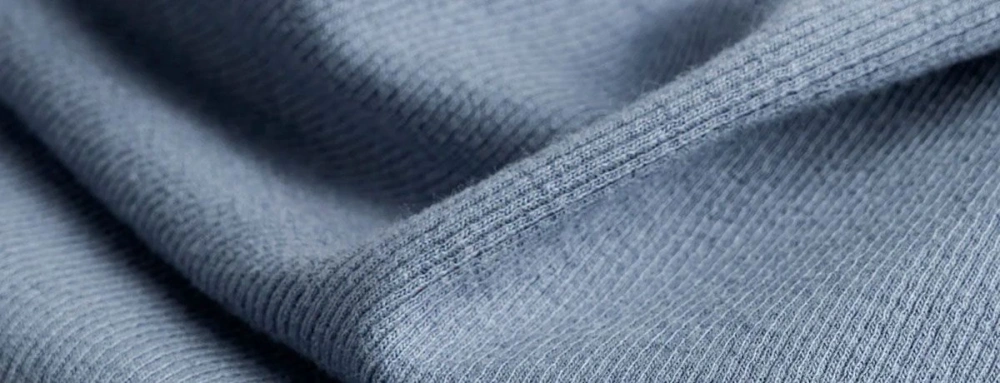Sewing with knit fabric opens up a whole new world of DIY possibilities. From comfy T-shirts to cozy leggings, knits are the perfect fabric for clothes that move with you. They’re stretchy, comfortable, and versatile—ideal for garments you’ll wear on repeat. And the best part? There’s no fraying to deal with, making them a little easier to handle than woven fabrics, especially if you’re just starting out.
In this guide, we’ll show you how to sew with knits, covering everything from the basics to some pro tips. You’ll learn about the essential tools, the best stitches to use, and how to sew smooth, stretchy seams. Whether you’re sewing your first knit piece or want to perfect your technique, we’ve got all the tips to help you sew like a pro. Let’s get started!
What is Knit Fabric?

Knit fabric is a super stretchy, comfy material made by looping yarns together in a special way. Unlike woven fabrics, where threads criss-cross at right angles, knits are made with loops, giving them a much more flexible feel.
This flexibility makes knits perfect for clothes that need to move with you—think T-shirts, leggings, or those cozy pajamas you love to wear. The stretchiness comes from how the fabric is made, which allows it to stretch in different ways, depending on the type.
When it comes to stretch, knit fabrics come in three types: 1-way stretch, 2-way stretch, and 4-way stretch. A 1-way stretch fabric only stretches in one direction (usually lengthwise), while 2-way stretch stretches both lengthwise and widthwise.
The most versatile is the 4-way stretch, which stretches in every direction, making it super flexible. Knowing the difference is important because it helps you pick the perfect fabric for your project—especially when it comes to comfort and fit.
Common Types of Knit Fabrics
Jersey Knit
Soft, lightweight, and perfect for casual tees, dresses, or leggings. With a smooth surface on one side and a looped texture on the other, it’s stretchy and comfy—ideal for all-day wear.
Interlock Knit
A thicker, double-sided knit that’s great for baby clothes, leggings, and skirts. It’s durable, soft, and looks the same on both sides, which makes it great for cozy, wearable pieces with a bit more weight.
Rib Knit
This fabric has a fun, raised texture that stretches in one direction, making it perfect for cuffs, necklines, and waistbands. You’ll see it a lot in sweaters, cardigans, and dresses because it fits comfortably and stretches just right.
French Terry Knit
If you’re after something cozy and soft, French terry is your go-to. It’s got a looped texture inside and a smooth exterior, making it a great choice for sweatshirts, loungewear, and robes. Think ultimate comfort without the bulk.
Fleece Knit
Warm, insulating, and super soft, fleece knit is perfect for jackets, blankets, and activewear. The brushed texture traps warmth, making it a favorite for colder weather and comfy winter gear.
Rayon Knit
Rayon knit fabrics are lightweight and drape beautifully, making them perfect for casual dresses, tops, and tunics. They have a nice flow to them, giving your outfits a bit of movement and style without being too stiff.
Double Knit
Thicker and more stable than other knits, double knit is the perfect choice for structured garments like jackets, trousers, or skirts. It has some extra weight and durability, making it great for items that need a bit of form.
Tricot Knit
Soft, silky, and lightweight, tricot knit is known for its smooth feel and stretch. It’s commonly used for lingerie, swimwear, and sleepwear, providing comfort and flexibility while keeping things sleek and stylish.
Essential Tools for Sewing Knit Fabrics
Stretch or Ballpoint Needle
When working with knits, a stretch or ballpoint needle is essential. These needles have rounded tips that glide effortlessly through fabric, ensuring a smooth stitch without damaging your material. Unlike universal needles, which can cause snags or holes, a ballpoint needle is the key to sewing knits with ease.
Sewing Machine
You don’t need a fancy serger to sew knits—your trusty sewing machine will do just fine. For most seams, stick with a straight stitch, but for added flexibility, switch to a stretch stitch or zigzag. If you have one, a walking foot will keep things smooth and prevent any shifting, especially with slippery knit fabrics.
Sewing Supplies
Your basic sewing tools like fabric scissors and pins are still necessary, but a few extras will make the process smoother. Clips are a great alternative to pins since they won’t leave holes or distort your fabric. Fabric weights are also a must for keeping everything in place while you cut, preventing unnecessary shifting.
Walking Foot
A walking foot is a lifesaver when sewing knits. This tool ensures that both layers of fabric move evenly through the machine, preventing any stretching or slippage. It’s especially helpful for stretchy fabrics that tend to move around as you sew.
Stretch Thread
For seams that need a little extra give, stretch thread is your best friend. It stretches with the fabric, keeping everything in place without causing puckering or pulling—especially in areas like sleeves or waistbands.
Choosing the Right Stitch for Knit Fabrics
Choosing the right stitch for knit fabrics can make a huge difference in your sewing results. Here’s a quick guide to help you pick the perfect stitch for your knit projects:
Stretch Stitch
This stitch is specifically designed to stretch with the fabric, preventing seams from breaking. If your machine has a dedicated stretch stitch, use it! Alternatively, a zigzag or overlock stitch offers similar flexibility.
Zigzag Stitch
A zigzag stitch is perfect for knits, especially for small seams or areas that require extra stretch. Adjust the width and length to ensure the stitch moves with the fabric without damaging it.
Serger Stitching
If you want clean, professional seams, a serger is the way to go. It trims and sews in one go, making it ideal for finishing knit fabric edges without fraying.
Twin Needle
Use a twin needle for adding decorative hems or finishing edges. It’s easy to set up with two spools of thread, and it creates parallel stitching for a polished look.
How to Sew Knit Fabric: Step-by-Step Guide

Sewing knits is easier than you might think! Follow these steps to get started:
Step 1: Practice on Scrap Fabric
Before diving into your main project, take a scrap piece of fabric to practice. This is your chance to test different stitches and get a feel for the fabric’s behavior.
Step 2: Pre-Shrink and Cut Fabric
Knits can shrink after washing, so be sure to wash and dry your fabric before cutting. Once it’s prepped, use a rotary cutter to ensure clean, precise cuts without stretching or warping.
Step 3: Choose the Right Needle and Stitch
For best results, opt for a ballpoint or stretch needle. These needles glide through the fabric with ease. Pair them with a stretch stitch or zigzag stitch to keep things stretchy and secure.
Step 4: Sew the Fabric
Sew slowly to avoid stretching the fabric as you go. A walking foot is a great tool for keeping everything aligned. Don’t forget to backstitch at the beginning and end of each seam to keep things secure.
Step 5: Press Seams
Pressing seams is essential for a polished look, but take it easy. Use low heat and steam to flatten seams without distorting the fabric. Be gentle to avoid stretching out the knit.
Step 6: Hem Your Fabric

When hemming, you’ve got a couple of options. A simple zigzag stitch will work for a clean, basic hem. But if you want something a bit more polished, try using a twin needle. It creates two parallel lines of stitching for a more professional finish.
Common Challenges and Solutions When Sewing Knit Fabrics
Sewing with knits can feel a bit tricky at first, but don’t worry—you’ve got this! Here are a few common problems you might face, and simple, practical fixes to help you power through them:
Problem 1: Puckering
Puckering is when your fabric starts to bunch up, creating those frustrating little ripples along the seam. It’s usually a tension issue, so first, check your machine’s tension and make sure it’s not too tight. Still having trouble? Try using a walking foot—it helps keep your fabric moving smoothly. And if it’s still bunching up, your needle might be the culprit—try swapping it out for a new one or a better fit for knits!
Problem 2: Skipped Stitches
Oh, skipped stitches—definitely one of the most annoying things when working with knits. Usually, it’s because your machine isn’t catching the fabric properly, often due to the wrong needle or thread.
Ballpoint or stretch needles are your best friends here—they’re designed to slide through knits without causing snags. Make sure you’re using stretch thread too, since it moves with the fabric. Also, try adjusting your stitch length—sometimes a slightly longer stitch works wonders!
Problem 3: Fabric Shifting or Stretching
If you’ve ever tried to sew knits and had the fabric shift or stretch out of shape, you know how tricky it can be. The best way to keep everything in place is with a walking foot—it helps keep the fabric layers moving evenly.
You can also adjust your presser foot pressure for more control, and be sure to gently guide the fabric as you sew. Don’t pull or stretch it—let the machine do the work and your fabric will stay nice and smooth.
Advanced Tips for Sewing with Knits
Adding Elastic
Elastic is a total game-changer when it comes to adding structure and fit to knit garments. It’s perfect for waistbands, cuffs, and hems that need some extra stretch. There are a few types of elastic to choose from, like knit or braided elastic, depending on how much stretch you need.
When adding it, simply sew it into the seam, stretching it as you go to make sure it fits snugly without distorting the fabric. You’ll get that comfy fit without sacrificing the flexibility of your knit fabric!
Decorative Stitches and Embellishments
Want to jazz up your knits? Adding decorative stitches, lace, or trim is a fun way to personalize your project. Just remember to keep the fabric’s stretch in mind! Use a stretch or zigzag stitch to ensure everything stays flexible. When adding lace or trim, opt for a looser stitch to avoid pulling or distorting the fabric.
Conclusion
You did it! Now that you’ve learned the basics of sewing with knits, you’re ready to tackle your projects with confidence. With the right needle, stretch stitches, and a bit of care, your knit garments will not only fit perfectly but look professionally made. Once you’ve mastered knits, a whole world of comfy and stylish options is at your fingertips.
Ready to jump into your first knit project? Start simple—think cozy tops or leggings—and don’t forget to have fun with it! As you practice, you’ll get better and better. And when you’re ready to take your skills to the next level, feel free to reach out to us at F&A Fabric for more advanced tips. Keep sewing, stay creative, and enjoy every stitch along the way!
